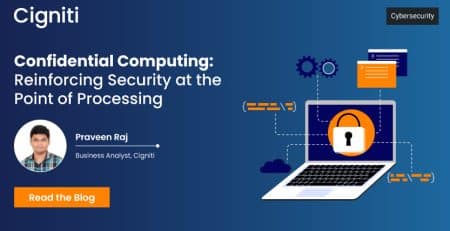Zero Trust Application Security: How To Implement
IT has evolved rapidly in response to digital transformation. Cloud computing, big data, the Internet of Things (IoT), and mobile internet have boosted productivity across all industries. Still, they have also added complexity to enterprise network infrastructures.
An increasingly blurred perimeter characterizes the enterprise network infrastructure, which is becoming more complex.
The enterprise’s digital walls are being transgressed by the adoption of cloud computing, mobile internet, and other technologies, while at the same time, the open and collaborative demands of new technologies, such as big data and the IoT, allow outside platforms to enter the enterprise.
The modern enterprise network infrastructure has no well-defined and well-recognized security perimeter.
The modern and complex enterprise network infrastructure needs a new security architecture to deal with the increasingly severe network threat.
As a result, the Zero Trust Architecture (ZTA) emerged as a natural evolution of security architectures and thinking.
What is Zero Trust Security
Zero Trust security is an IT security tactic encompassing stringent identity verification for anyone accessing resources on a private network perimeter.
Although Zero Trust Network Access (ZTNA) is the most commonly identified technology in the Zero Trust architecture, Zero Trust is a holistic approach to network security encompassing various ideas and technologies.
In other words, typical IT network security trusts everyone and everything on the network. No one and nothing is charged in a zero-trust architecture.
Traditional network security, which followed the “trust but verify” strategy, has been replaced by Zero Trust.
The conventional approach automatically trusted users and endpoints within the organization’s perimeter, exposing the organization to dangerous internal actors and rogue credentials, granting unauthorized and compromised accounts broad access once inside.
With the cloud migration of corporate transformation activities, this approach has become antiquated and, in some cases, outdated.
As a result, enterprises must constantly monitor and check that a user and their device have the appropriate access and attributes.
It necessitates the organization’s knowledge of all service and privileged accounts and the ability to impose restrictions on what and where they connect.
Because threats and user properties are all subject to change, a one-time validation will not suffice.
Therefore, organizations must ensure that all access requests are continually vetted before allowing connection with any of their enterprise or cloud assets.
To enforce Zero Trust policies, you need real-time visibility into user credentials.
Why Zero Trust Matters
There has been a growing need for zero trust security since mobile users began connecting to business applications via unmanaged devices over the internet.
“Zero trust” sounds like a good idea when you can’t trust the connection, device, or network.
Today’s networks are hostile environments. They are ripe for attack because they host business-critical applications and data.
While no security system is perfect, and security breaches will never be eradicated, zero trust decreases the attack vector and thresholds, the wing span, and the impact and severity of a cyberattack, reducing the time and cost of responding to and cleaning up after a data breach.
One of the most effective ways businesses limit access to their networks, applications, and data is to use zero trust.
It integrates a wide range of preventative approaches, such as identity verification and behavioral analysis, micro-segmentation, endpoint security, and most minor privilege controls to deter would-be attackers and limit their access in the event of a breach.
A hacked account that passes authentication methods at a network perimeter device should nevertheless be examined for each subsequent session or endpoint it attempts to access.
Instead of assuming that a connection via VPN or SWG is safe and trusted, having the capacity to distinguish typical from abnormal activity helps enterprises tighten authentication rules and regulations.
This additional layer of security is crucial as businesses expand their networks to incorporate cloud-based apps and servers, not to mention the growth of service accounts on microsites and other machines hosted locally, on virtual machines, or via SaaS.
These tendencies make establishing, monitoring, and maintaining secure perimeters increasingly complex.
Furthermore, a borderless security policy is critical for enterprises with a worldwide workforce and employees who work remotely.
Finally, Zero Trust security helps the company contain breaches and minimize possible damage by segmenting the network by identity, groups, and purpose and controlling user access.
Rogue credentials are used to organize some of the most complex assaults, so this is a critical security step.
From online apps to network monitoring and security, all networks have automated upgrades built into their technology stack.
Patching should be automated if you want to keep your network clean. However, Zero Trust implies anticipating harmful behavior even for obligatory and automated upgrades.
Zero Trust and the idea of least privilege necessitate stringent restrictions and permissions for service accounts.
In general, service accounts should have well-defined behaviors and connection privileges.
They should never attempt to access a domain controller or authentication system directly, and any abnormal behavior should be noticed and escalated as soon as possible.
Zero Trust is a process, not a destination, and it is imperative to implement core zero-trust security principles to keep your company network safe from internal and external threats and secure your applications.
Core Principles of Zero Trust Security
For company IT departments, perimeter security is no longer the best solution. A considerably more adaptable design that prioritizes users, devices, and services is required.
Zero trust was created to combat present and future IT security threats by assuming that no one, device, or service, inside or outside the corporate network, can be trusted.
Using a dynamic digital identity-based perimeter, the zero trust security architecture establishes core vital capabilities, including an identity-based schema for resource secure access, continuous trust evaluation, and adaptive access control (AAC).
The core concepts of zero trust are detailed below to ensure that zero trust is successfully adopted into a long-term IT strategy.
Understand what needs to be guarded.
All users, devices, data, and services comprise an organization’s IT-protected surface. The protected surface must also include the method of transport for sensitive firm data, which is the network. The protected character for most enterprises today goes far beyond the protection of a corporate LAN, which is one of the key reasons why zero-trust architectures have grown so popular.
Because many data flows no longer cross into the corporate network, traditional perimeter or edge security measures no longer have the same reach. Because of the shift in data streams, cybersecurity technologies must be extended beyond the network edge to get as close as possible to apps, data, and devices. Automated asset and service inventory tools should be used to support manual inventory processes.
Combining these technologies aids teams in determining which apps, data, and devices should be prioritized for security. These technologies are also used to determine the location of essential resources and who should have access to them. This procedure effectively creates a map for security architects to determine where security technologies should be used.
Recognize the cybersecurity mechanisms that are already in place
The second concept of zero trust is to evaluate what cybersecurity controls are already in place after the protected surface has been mapped. When implementing a zero-trust strategy, many of the IT department’s existing security technologies will likely be helpful.
They may, however, be put in the incorrect area or employ an out-of-date perimeter architecture paradigm. When combined with the protected surface map, these assessment activities allow IT security architects to see where existing solutions can be repurposed or redeployed to reach the new locations where cloud and other web resources are located.
New tools and contemporary architecture must be implemented
Regarding a complete zero-trust architecture, existing cybersecurity tools will not suffice in most cases. During the implementation of zero-trust, security gaps were identified. Extra tools must be implied to give further layers of protection. Unfortunately, traditional security measures aren’t as effective as they once were.
To meet zero-trust framework requirements, enterprise IT shops often implement tools such as network micro-segmentation, single sign-on for all applications and data, and multifactor authentication. In addition, advanced threat protection tools can identify emerging threats and push security policies to resources exactly where they are needed across the protected surface.
Implement a comprehensive policy.
When all the technologies needed to establish a zero-trust architecture are in place, security administrators are responsible for putting them to work. This is accomplished by establishing and enforcing a zero-trust policy, which may be applied to various security technologies.
Zero-trust policies allow access to resources only when essential, based on a stringent set of norms. According to guidelines, users, devices, and apps should have access to all the data and services at any time. Administrators can configure security devices to follow the whitelist of permit rules while refusing everything else once the high-level policies have been created.
Keep an eye on things and send out alerts.
Conducting essential monitoring and using warning technologies is the final principle of zero trust. These technologies provide security personnel with the necessary level of visibility into whether security policies are being followed and whether flaws in the framework have been exploited.
Even with a zero-trust architecture, realizing that nothing is fully secure is crucial. When malicious behaviors occur, tools must still be employed to capture them so that they may be rapidly eradicated. Root cause analysis should also be performed to discover and correct any gaps in the current security posture.
Security operations center administrators may find it challenging to adequately monitor a distributed security architecture like zero trust. Modern cybersecurity monitoring systems, which include automation and AI capabilities, can help alleviate this strain.
Modern security monitoring solutions, such as network detection and response and security orchestration, automation, and response, reduce the human resources necessary to notice security issues while identifying root causes and remedial methods.
While it is imperative to adhere to the core principles of Zero Trust Security, knowing how to enhance enterprise application security using the Zero Trust security model is essential.
How to boost the enterprise’s application security using the Zero Trust Application Security
Many businesses are concerned about application security and with good reason. However, you can take action to mitigate at least some of the dangers.
The security dangers of running business-critical apps in unprotected environments, as are application breaches, are on the rise.
Companies also wait until after a breach occurs to invest appropriately in application security, resulting in a loss of productivity, customer trust, and income.
Here are a few steps to boosting your enterprise application security using the Zero Trust Security model.
Frameworks
The first and most critical stage is setting frameworks in place, which involves identifying the best practices an enterprise will use to manage its cybersecurity risk. The zero-trust security approach aims to make businesses more robust to cyber threats by recognizing and eliminating ambiguity in implementing security rules continuously.
Enterprises cannot identify and stop every attack, but zero trust techniques can improve a company’s security posture by developing ways to give and regulate access throughout the network.
Keep your APIs safe.
For attackers, anything that exposes an application to unauthorized access is acceptable. This includes APIs, even though their attack surfaces are often limited.
When APIs are used to produce content on a website dynamically, security is often disregarded. Hackers use malware to take over a mobile device or steal credentials and target mobile APIs. They use the API to scrape data from their target once they gain access.
APIs must be assessed regarding the level of access to sensitive data and the resources they provide. For other elements of apps, this is just as crucial as security.
Secure the Internet Network
Applications and workloads have shifted to the cloud, and users can now access them anywhere. As a result, the network is no longer considered a secure enterprise network. Instead, the internet is unprotected.
Most firms’ network perimeter security and visibility solutions are no longer practicable or robust enough to keep intruders out. Zero trust relies on least privilege and “always-verify” concepts to provide total network visibility in data centers or the cloud.
Have clear visibility of how applications perform in different scenarios
Breaking an application in the hope of exposing an attack surface is a typical approach used by threat actors. Buffer overflows are a common occurrence. Organizations should “fuzz” their apps to protect themselves from such attacks. This entails testing an app with various unexpected inputs to see how it reacts.
Attackers can be highly inventive when determining how applications will respond. That’s why having clear visibility into how applications perform in various scenarios should be a top focus for businesses.
Micro-segmentation
This allows businesses to divide physical networks into thousands of logical micro-segments, which are then protected, reducing risk by allowing only those granted access to view the data. Micro-segmentation aims to keep the attack surface as small as possible while preventing unauthorized lateral movement.
Depending on the approach utilized, security experts might establish secure zones to segregate environments, data centers, applications, and workloads across on-premise, cloud, and hybrid network environments.
In the past, organizations could rely on whatever was available on the network.
While the tale of security breaches continues, we must implement cutting-edge innovation, such as the zero-trust model, which mandates monitoring tools and automated abilities to respond to such situations swiftly.
To properly comprehend Zero Trust at a granular level, we must first realize the challenges businesses confront while establishing a Zero Trust architecture.
Challenges of Zero Trust Security and how to overcome them
The zero-trust security approach has been marketed as a fail-safe defense against unknown and developing threats.
Unlike perimeter security, it does not assume that people inside an organization are immediately safe. Instead, it requires every user inside and outside the company to get approved before being granted access.
Here are a few obstacles to zero-trust networking and some suggestions for overcoming them.
When it comes to zero-trust cybersecurity, a fragmented approach might lead to vulnerabilities.
Zero-trust cybersecurity may lead to better security in the long run, but it might endanger businesses.
Most businesses tailor their strategies piecemeal, but loopholes or cracks might emerge, making zero trust less reliable than stated. At the same time, unwinding a legacy system can lead to security gaps that weren’t anticipated.
Zero-trust cybersecurity necessitates a commitment to ongoing management
Another standard stumbling block to implementing a zero-trust cybersecurity paradigm is the necessity for continual management. Zero-trust models rely on a vast network of well-defined permissions, yet businesses constantly change.
People take up new responsibilities and relocate. Access restrictions must be updated regularly to guarantee that the relevant people have access to specific information. Constant input is required to keep the permissions accurate and up to date.
Impact on productivity
Introducing a zero-trust cybersecurity approach could hurt productivity. The most challenging aspect of zero trust is restricting access without halting workflows. People need access to sensitive data to work, communicate, and collaborate.
Individual’s productivity can suffer if they switch positions and are shut out of files or applications for a week. In the worst-case scenarios, losing productivity becomes more significant than cybersecurity.
Overcoming these challenges
Avoiding thinking of zero trust in binary terms is the best approach to managing the inherent risks. Companies can implement a zero-trust architecture while keeping their existing systems.
Begin by determining the most critical data and workflows. Stricter access controls, such as multifactor authentication, privileged access, and session management, can be applied to them.
The rest of the data is subject to regular perimeter restrictions, while only the most sensitive data is held to a zero-trust standard.
The benefits of gradually implementing zero-trust security are that it does not disturb the continuity of a cybersecurity plan.
Companies are beginning to secure critical assets, yet they are exposed to fewer dangers since they are not abandoning one system entirely for another.
Data breaches continue despite the efforts of the broad cybersecurity community.
On the other hand, zero-trust cybersecurity focuses on securing assets rather than merely entry points to combat this.
Companies can advance their security posture as long as they grasp the problems of zero trust.
Closing Thoughts
Cigniti’s Managed Security Testing Services methodology is based on industry best practices and a decade of experience delivering software testing services, guaranteeing that your applications are secure, scalable, and flexible. Our web application penetration and security testing reveal application vulnerabilities, minimize application risks, and assess your software code for better quality assurance. Our security testing services for many industry verticals and businesses ensure cyber safety, resulting in a strong brand image and client retention.
The key differentiators of our dynamic application Security Testing Services are:
- Standardized methodologies aligned to OWASP, Open SAMM & OSTTM.
- Testing performed from the Hacker’s Eye View.
- Continuous testing platform with built-in security engineering and testing.
- Next Generation IP – BlueSwan™ that comes with a Model-Based Testing Tool (Prudentia) & Reporting Dashboard Verita for SLA/KPI monitoring; CxO dashboards; Predictive analytics that helps in faster decision making, leading to faster time-to-market.
- Industry-recognized Certifications of our security test experts include Certified Ethical Hacker, Licensed Penetration Tester Master, Certified Information Systems Security Professional, Certified Information Systems Auditor, and Certified Information Security Manager.
Need help? Consult Cigniti’s team of experienced security testing experts to understand how to implement Zero Trust to secure your applications.





Leave a Reply